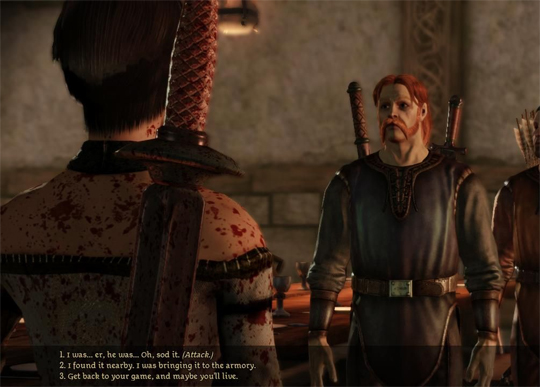Many of us are familiar with the uncanny valley — the idea that at a certain point, the more closely the visual representation of humans resembles reality, the more objectionable minor discrepancies will become until this “valley” (as seen on a line graph) of repulsion is passed. Since its original postulation, which was applied to humanoid robots, the hypothesis has been expanded to cover CG character design in film and video games, and even the virtual worlds constructed for those mediums. But can this concept also apply to gameplay mechanics that aim to recreate the complexity of real-world behavior and interaction, or that aim to emulate other games that exist outside of the virtual realm?
In the beginning, video games couldn’t dream of recreating anything with a respectable degree of realism in terms of graphics nor gameplay, but with the advent of 3D, gameplay’s uncanny valley began to emerge. In the early days of 3D, invisible walls vexed gamers with their absurd and inexplicable prevention of players to fully traverse the new, “realistic” worlds whose scale and substance just begged for exploration. As visuals continued to approach realism, suspension of disbelief became even more difficult when players’ characters could carry too many (or too few) items at once, when they couldn’t aim at two targets simultaneously, when they continued to take turns attacking in battle, or when they were forced to find keys for doors instead of using alternate routes or simply smashing straight through to their goal destinations. The visual elements of these games were met with their own criticisms, but it is ultimately gameplay that matters most to a majority of the audience; dissatisfaction with the way games “feel” has troubled gamers throughout gaming history.
One might think that video games have reached a plateau with the current console generation, wherein realism is as acceptable as it will ever be. But if that were true, then why are complaints seemingly more common now than ever before? Why are there more voices decrying the flaws of every new release, week-in and week-out? It’s uncanny, unbelievable how we continue to find fault with them, no matter how much improvement is shown by our newest and most finely crafted games.
It seems that the more a game offers, the more obvious are the smaller things it doesn’t bring to the table. An example of this is the recently released Dragon Age: Origins, a western RPG from the talented people of BioWare. This game, as evidenced by its roughly 92% average review score, is an enjoyable and laudable gaming experience, however, I find my fun stymied by a few of my figurative steps through the aforementioned valley, both vague and specific. The general feeling I get from Dragon Age, after the realization and understanding that it does a good job incrementing the evolution of the genre it clings so loyally to, is a forlorn emptiness about my connection with the game’s mechanics and general flow. As a one-time tabletop RPG player, I can relate Dragon Age to those gaming experiences (upon which the western-RPG template is based) as a work that admires them, tries to re-imagine them for a digital age, and ultimately — sadly — fails to do so in a comprehensive way.

Summarily, it comes down to the apparent freedoms afforded to players by the game’s broad design choices that turn out to be less free than one would hope. From minute inconveniences as trivial as not being able to use an item directly from a specific part of the menu, to fundamental systems of player-influenced character and plot development, gameplay’s uncanny valley clearly reveals itself. Specifically regarding dialog, players are confined by the restrictions of the pre-programmed text responses and conversation arches, but are simultaneously allowed to loop around and through these limited selections, repeating, retrying, and retreading the essential core of the role-playing experience. The concepts of choice and consequence are at once bestowed and withheld. This has been a drawback of heavily conversationally driven RPGs for as long as they have existed, and until the technology of video games can rival the creativity and adaptability of the human mind as it receives, perceives, and responds to players’ unique and diverse input, the shortcoming will remain.
Players may not be able to say the things they would truly like to say in games like this, and even more frustrating, they may be asked to choose from lists of responses comprised entirely of things they don’t want to say. Free will is drained from these virtual interactions, and players are forced to settle for behavior that falls outside the theoretical maps of their characters or personal play styles. The same effect is exhibited in facets of gameplay other than simple chit chat. Games often require players to carry out certain tasks before they can proceed at all. There are no options in these situations for players to simply not do what the developers want them to do. More appropriately, there are no options in these situations for players to do anything the developers haven’t considered as viable alternatives. While real life or human-governed game settings potentially have 30-odd solutions to a given problem, video games are considered “open-ended” if they offer a meager three or four. Again, as we are given greater freedom to explore the possibilities of our virtual worlds, the impossibilities of those worlds become more painfully obvious thanks to the uncanny valley of gameplay.
Do not misinterpret this line of thought as suggesting that game developers are at fault in such situations, or that the games in question are “bad”; this is more a matter of technological limitation and relativity in human perception when assessing these games. We can’t help but feel this way about smaller and smaller problems as gameplay nears perfection. Just as in the uncanny valley of visual realism, the quality of the surrounding content will always magnify the weakest links in gameplay’s uncanny valley, and gamers will always take note. “Nit-picking” has never gone out of style.


















